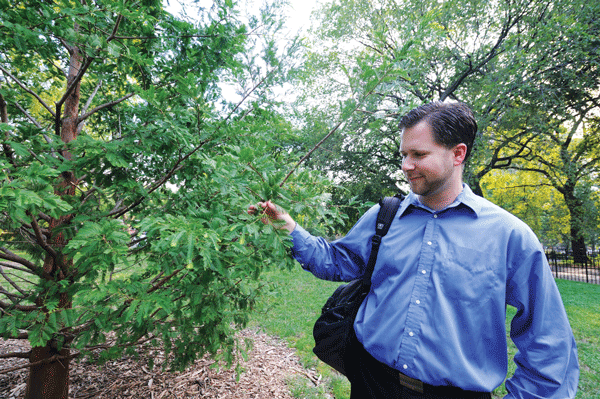
BY TERESE LOEB KREUZER | Not far from a towering American elm tree (Ulmus Americana) in Tompkins Square Park, a baby dawn redwood, now just a little more than 15 feet tall, stands amid a circle of mulch on a sunny lawn. But in a few decades, the baby (Metasequoia glyptostroboides) will also be a giant of 100 feet or more. In fact, these trees can grow 6 feet a year and have been known to reach a height of 200 feet.
Around 50 years ago, Dutch elm disease wiped out most of the American elm trees in the United States. A grove of them in Tompkins Square Park survived, partially because the trees were planted far enough apart so that their roots didn’t touch — one of the ways in which Dutch elm disease, a fungus, was spread. The East Village’s Tompkins Square Park opened in 1850. Its elms may be nearly that old.
Metasequoia glyptostroboides is also a survivor. It is in the same subfamily as the famous giant redwoods of the Sierra Nevada Mountains in California, but it is the only living species of its genus. In 1941, fossils of Metasequoia glyptostroboides were found in the Sichuan-Hubei region of China. They dated to the Mesozoic era — 250 million to 65 million years ago, when dinosaurs were still alive. The tree was thought to be extinct.
Two years later, a few living trees were discovered in Hubei, but because of World War II, they weren’t studied until 1946. Finally, in 1948, Metasequoia glyptostroboides was classified as a new living species. The Arnold Arboretum at Harvard University collected seeds from three trees and distributed them to other arboretums and universities.
Descendants of those three trees have been planted in parks and gardens worldwide. There are five of these trees in Battery Park City — one on the esplanade at Third Place and four in Rockefeller Park. There is also a large specimen on East Houston St. at the Bowery in the Liz Christy Community Garden — New York City’s first community garden, which opened in 1973. That tree is now taller than the nine-story building next to which it was planted.
The tree is still considered “critically endangered” in its native China.
“Metasequoia is such a big deal because we thought it was extinct,” said Matthew Stephens, director of street tree planting for the city Parks Department. “It’s definitely not common now, but it is accessible. This is the equivalent of finding a dinosaur somewhere on the planet still alive in a tucked-away corner and then redistributing it throughout the world so that people could have it in their backyard.”
Tompkins Square Park’s Metasequoia glyptostroboides was planted in November 2011 by the New York Restoration Project, a nonprofit organization founded by Bette Midler dedicated to transforming open spaces in the city’s underserved communities.
In 2007, Mayor Bloomberg launched the Million Trees NYC initiative in conjunction with the New York Restoration Project. The plan was to plant 1 million trees in New York City by 2017. Since the project started, 613,000 trees have been planted, with five years to go. Even before the Million Trees NYC initiative, New York City had one of the largest and most diverse urban forests in the country. Currently, there are around 625,000 trees on New York City streets and a total of around 5.2 million trees in the five boroughs.
Anne Tan, a Restoration Project spokesperson, said that although Midler didn’t know Apple C.E.O. Steve Jobs personally, she was so moved by his life and death that she wanted to do something to memorialize him.
“It made sense, with the mission of our organization, to plant a tree to honor him,” Tan said. “Tompkins Square Park had recently lost a significant tree and the Jobs tree was an opportunity to restore a spectacular tree at that location.”
Tan said the dawn redwood was chosen because it is similar to the sequoias of Northern California where Jobs lived. A plaque in Tompkins Square Park records the gift. It says, “In Honor of Steve Jobs. Stay Hungry. Stay Foolish.”
Metasequoia glyptostroboides is one of two deciduous conifers. The other is the bald cypress (Taxodium distichum), a specimen of which is also in Tompkins Square Park near the large, central elm tree. Unlike most conifers, which keep their needles all year long, these lose their needles as the weather cools; they fade to a cinnamon color before they fall off.
“The earliest trees on the planet were conifers because it’s a simple reproduction method — seeds and cones,” Stephens said. “It doesn’t rely on wind or insects or anything else to reproduce. Taxodium and Metasequoia are genetically very close. Taxodium is a little more common than Metasequoia, but it is certainly not your everyday tree.”
The bald cypress is native to the southeastern United States, and like the dawn redwood, is of ancient ancestry. Bald cypress fossils have been found dating from the Jurassic era, 200 million to 146 million years ago. These trees can live more than 1,000 years. A specimen in Bladen County, North Carolina, is more than 1,620 years old.
Tompkins Square Park’s Taxodium was planted six to eight years ago, according to Stephens, and is still a spindly baby. Because they are tolerant of urban pollution, both Taxodium and Metasequoia have also been planted along New York City streets, he said.
Stephens called Metasequoia glyptostroboides “the comeback story of conservation” that hasn’t been replicated elsewhere.
“Tigers, pandas — everything has been a struggle,” he said. “Metasequoias aren’t found everywhere, but you can go to many local garden centers and probably find a couple. This really can be traced back to half a dozen people who found it, figured they could do something about it, and then actually did.”

















